Modeling Impacts of Urbanization on Winter Boundary Layer Meteorology and Aerosol Pollution in the Central Liaoning City Cluster, China
Abstract
1. Introduction
2. Materials and Methods
2.1. Materials
2.2. Observation Data
2.3. Model Validation
3. Results and Analysis
3.1. Pollution Process of the CLCC from 1 to 5 January 2020
3.2. The Impacts of Urbanization on Regional Atmospheric Diffusion Capacity
3.3. The Impacts of Urbanization on Regional PM2.5
4. Conclusions
Author Contributions
Funding
Institutional Review Board Statement
Informed Consent Statement
Data Availability Statement
Acknowledgments
Conflicts of Interest
References
- Chen, L.; Zhang, M.; Zhu, J.; Wang, Y.; Skorokhod, A. Modeling impacts of urbanization and urban heat island mitigation on boundary layer meteorology and air quality in Beijing under different weather conditions. J. Geophys. Res. Atmos. 2018, 123, 4323–4344. [Google Scholar] [CrossRef]
- Li, D.; Bou-Zeid, E. Synergistic interactions between urban heat islands and heat waves: The impact in cities is larger than the sum of its parts. J. Appl. Meteorol. Climatol. 2013, 52, 2051–2064. [Google Scholar] [CrossRef]
- Sharma, R.; Joshi, P.K. Mapping environmental impacts of rapid urbanization in the National Capital Region of India using remote sensing inputs. Urban Clim. 2016, 15, 70–82. [Google Scholar] [CrossRef]
- Fan, C.; Myint, S.; Kaplan, S.; Middel, A.; Zheng, B.; Rahman, A.; Huang, H.-P.; Brazel, A.; Blumberg, D.G. Understanding the Impact of Urbanization on Surface Urban Heat Islands—A Longitudinal Analysis of the Oasis Effect in Subtropical Desert Cities. Remote Sens. 2017, 9, 672. [Google Scholar] [CrossRef]
- Li, Y.; Zhang, J.; Sailor, D.J.; Ban-Weiss, G.A. Effects of urbanization on regional meteorology and air quality in Southern California. Atmos. Chem. Phys. 2019, 19, 4439–4457. [Google Scholar] [CrossRef]
- Jacobson, M.Z.; Nghiem, S.V.; Sorichetta, A.; Whitney, N. Ring of impact from the mega-urbanization of Beijing between 2000 and 2009. J. Geophys. Res. Atmos. 2015, 120, 5740–5756. [Google Scholar] [CrossRef]
- Wang, J.; Feng, J.; Yan, Z.; Hu, Y.; Jia, G. Nested high-resolution modeling of the impact of urbanization on regional climate in three vast urban agglomerations in China. J. Geophys. Res. 2012, 117, D21103. [Google Scholar] [CrossRef]
- Li, M.; Song, Y.; Mao, Z.; Liu, M.; Huang, X. Impacts of thermal circulations induced by urbanization on ozone formation in the Pearl River Delta region, China. Atmos. Environ. 2016, 127, 382–392. [Google Scholar] [CrossRef]
- Ryu, Y.-H.; Baik, J.-J.; Kwak, K.-H.; Kim, S.; Moon, N. Impacts of urban land-surface forcing on ozone air quality in the Seoul metropolitan area. Atmos. Chem. Phys. 2013, 13, 2177–2194. [Google Scholar] [CrossRef]
- Liao, J.; Wang, T.; Jiang, Z.; Zhuang, B.; Xie, M.; Yin, C.; Wang, X.; Zhu, J.; Fu, Y.; Zhang, Y. WRF/Chem modeling of the impacts of urban expansion on regional climate and air pollutants in Yangtze River Delta, China. Atmos. Environ. 2015, 106, 204–214. [Google Scholar] [CrossRef]
- Zhu, B.; Kang, H.; Zhu, T.; Su, J.; Hou, X.; Gao, J. Impact of Shanghai urban land surface forcing on downstream city ozone chemistry. J. Geophys. Res. Atmos. 2015, 120, 4340–4351. [Google Scholar] [CrossRef]
- Lai, A.; Liu, Y.; Chen, X.; Chang, M.; Fan, Q.; Chan, P.; Wang, X.; Dai, J. Impact of land-use change on atmospheric environment using refined land surface properties in the Pearl River Delta, China. Adv. Meteorol. 2016, 2016, 3830592. [Google Scholar] [CrossRef]
- Dai, J.; Wang, X.; Dai, W.; Chang, M. The impact of inhomogeneous urban canopy parameters on meteorological conditions and implication for air quality in the Pearl River Delta region. Urban Clim. 2019, 29, 100494. [Google Scholar] [CrossRef]
- Kang, H.; Zhu, B.; de Leeuw, G.; Yu, B.; van der A, R.J.; Lu, W. Impact of urban heat island on inorganic aerosol in the lower free troposphere: A case study in Hangzhou, China. Atmos. Chem. Phys. 2022, 22, 10623–10634. [Google Scholar] [CrossRef]
- Mika, J.; Forgo, P.; Lakatos, L.; Olah, A.B.; Rapi, S.; Utasi, Z. Impact of 1.5 K global warming on urban air pollution and heat island with outlook on human health effects. Curr. Opin. Env. Sust. 2018, 30, 151–159. [Google Scholar] [CrossRef]
- Yang, Z.; Yang, B.; Liu, P.; Zhang, Y.; Yuan, X.-C. Impact of temperature on physical and mental health: Evidence from China. Weather Clim. Soc. 2021, 13, 709–727. [Google Scholar] [CrossRef]
- Xu, C.; Zhang, Z.; Ling, G.; Wang, G.; Wang, M. Air pollutant spatiotemporal evolution characteristics and effects on human health in North China. Chemosphere 2022, 294, 133814. [Google Scholar] [CrossRef]
- Wang, P.; Yang, Y.; Li, H.; Chen, L.; Dang, R.; Xue, D.; Li, B.; Tang, J.; Leung, L.R.; Liao, H. North China Plain as a hot spot of ozone pollution exacerbated by extreme high temperatures. Atmos. Chem. Phys. 2022, 22, 4705–4719. [Google Scholar] [CrossRef]
- Wang, X.; Wu, Z.; Liang, G. WRF/CHEM modeling of impacts of weather conditions modified by urban expansion on secondary organic aerosol formation over Pearl River Delta. Particuology 2009, 7, 384–391. [Google Scholar] [CrossRef]
- Chen, F.; Kusaka, H.; Bornstein, R.; Ching, J.; Grimmond, C.S.B.; Grossman-Clarke, S.; Loridan, T.; Manning, K.M.; Martilli, A.; Miao, S. The integrated WRF/urban modelling system: Development, evaluation, and applications to urban environmental problems. Int. J. Climatol. 2011, 31, 273–288. [Google Scholar] [CrossRef]
- Flanner, M.G. Integrating anthropogenic heat flux with global climate models. Geophys. Res. Lett. 2009, 36, L02801. [Google Scholar] [CrossRef]
- Miao, S.; Chen, F.; LeMone, M.A.; Tewari, M.; Li, Q.; Wang, Y. An observational and modeling study of characteristics of urban heat island and boundary layer structures in Beijing. J. Appl. Meteorol. Climatol. 2009, 48, 484–501. [Google Scholar] [CrossRef]
- Yang, L.; Niyogi, D.; Tewari, M.; Aliaga, D.; Chen, F.; Tian, F.; Ni, G. Contrasting impacts of urban forms on the future thermal environment: Example of Beijing metropolitan area. Environ. Res. Lett. 2016, 11, 034018. [Google Scholar] [CrossRef]
- Singh, A. Role of Atmospheric Boundary Layer (ABL) Height and Ventilation Coefficient on Urban Air Quality- A study based on Observations and NWP Model. J. Atmos. Sci. Res. 2019, 2, 11–16. [Google Scholar] [CrossRef]
- Wang, X.; Lin, W.; Yang, L.; Deng, R.; Lin, H. A numerical study of influences of urban land-use change on ozone distribution over the Pearl River Delta region, China. Tellus B 2007, 59, 633–641. [Google Scholar] [CrossRef]
- Liu, H.; Ma, W.; Qian, J.; Cai, J.; Ye, X.; Li, J.; Wang, X. Effect of urbanization on the urban meteorology and air pollution in Hangzhou. J. Meteorol. Res. 2016, 29, 950–965. [Google Scholar] [CrossRef]
- Zhu, K.; Xie, M.; Wang, T.; Cai, J.; Li, S.; Feng, W. A modeling study on the effect of urban land surface forcing to regional meteorology and air quality over South China. Atmos. Environ. 2017, 152, 389–404. [Google Scholar] [CrossRef]
- Li, H.; Meier, F.; Lee, X.; Chakraborty, T.; Liu, J.; Schaap, M.; Sodoudi, S. Interaction between urban heat island and urban pollution island during summer in Berlin. Sci. Total Environ. 2018, 636, 818–828. [Google Scholar] [CrossRef]
- Martilli, A.; Roulet, Y.-A.; Junier, M.; Kirchner, F.; Rotach, M.W.; Clappier, A. On the impact of urban surface exchange parameterisations on air quality simulations: The Athens case. Atmos. Environ. 2003, 37, 4217–4231. [Google Scholar] [CrossRef]
- Lee, S.-H.; Kim, S.-W.; Angevine, W.M.; Bianco, L.; McKeen, S.A.; Senff, C.J.; Trainer, M.; Tucker, S.C.; Zamora, R.J. Evaluation of urban surface parametrizations in the WRF model using measurements during the Texas Air Quality Study 2006 field campaign. Atmos. Chem. Phys. 2011, 11, 2127–2143. [Google Scholar] [CrossRef]
- Salamanca, F.; Martilli, A.; Tewari, M.; Chen, F. A Study of the Urban Boundary Layer Using Different Urban Parameterizations and High-Resolution Urban Canopy Parameters with WRF. J. Appl. Meteorol. Climatol. 2011, 50, 1107–1128. [Google Scholar] [CrossRef]
- Liao, J.; Wang, T.; Wang, X.; Xie, M.; Jiang, Z.; Huang, X.; Zhu, J. Impacts of different urban canopy schemes in WRF/Chem on regional climate and air quality in the Yangtze River Delta, China. Atmos. Res. 2014, 145–146, 226–243. [Google Scholar] [CrossRef]
- Kang, H.-Q.; Zhu, B.; Zhu, T.; Sun, J.-L.; Ou, J.-J. Impact of Megacity Shanghai on the Urban Heat-Island Effects over the Downstream City Kunshan. Bound.-Lay. Meteorol. 2014, 152, 411–426. [Google Scholar] [CrossRef]
- Tao, W.; Liu, J.; Ban-Weiss, G.A.; Hauglustaine, D.A.; Zhang, L.; Zhang, Q.; Cheng, Y.; Yu, Y.; Tao, S. Effects of urban land expansion on the regional meteorology and air quality of eastern China. Atmos. Chem. Phys. 2015, 15, 8597–8614. [Google Scholar] [CrossRef]
- Wang, Y.; Lu, Z.; Zhao, H.; Ma, Y. The impact of urbanization development on the meteorological and environmental elements in the central cities of Liaoning Province. IOP Conf. Ser. Earth Environ. Sci. 2020, 446, 032107. [Google Scholar] [CrossRef]
- Miao, Y.; Guo, J.; Liu, S.; Zhao, C.; Li, X.; Zhang, G.; Wei, W.; Ma, Y. Impacts of synoptic condition and planetary boundary layer structure on the trans-boundary aerosol transport from Beijing-Tianjin-Hebei region to Northeast China. Atmos. Environ. 2018, 181, 1–11. [Google Scholar] [CrossRef]
- Li, X.; Wang, Y.; Shen, L.; Zhang, H.; Zhao, H.; Zhang, Y.; Ma, Y. Characteristics of boundary layer structure during a persistent haze event in the Central Liaoning city cluster, Northeast China. J. Meteorol. Res. 2018, 32, 302–312. [Google Scholar] [CrossRef]
- Li, X.; Hu, X.; Ma, Y.; Wang, Y.; Li, L.; Zhao, Z. Impact of planetary boundary layer structure on the formation and evolution of air-pollution episodes in Shenyang, Northeast China. Atmos. Environ. 2019, 214, 116850. [Google Scholar] [CrossRef]
- Li, X.; Hu, X.; Shi, S.; Shen, L.; Luan, L.; Ma, Y. Spatiotemporal variations and regional transport of air pollutants in two urban agglomerations in Northeast China plain. Chin. Geogr. Sci. 2019, 29, 917–933. [Google Scholar] [CrossRef]
- Li, X.; Miao, Y.; Ma, Y.; Yang, Y.; Zhang, Y. Impacts of synoptic forcing and topography on aerosol pollution during winter in Shenyang, Northeast China. Atmos. Res. 2021, 49, 105764. [Google Scholar] [CrossRef]
- Grell, G.A.; Peckham, S.E.; Schmitz, R.; McKeen, S.A.; Frost, G.; Skamarock, W.C.; Eder, B. Fully coupled “online” chemistry within the WRF model. Atmos. Environ. 2005, 39, 6957–6975. [Google Scholar] [CrossRef]
- Lin, Y.-L.; Farley, R.D.; Orville, H.D. Bulk parameterization of the snow field in a cloud model. J. Clim. Appl. Meteorol. 1983, 22, 1065–1092. [Google Scholar] [CrossRef]
- Chen, S.-H.; Sun, W.-Y. A one-dimensional time dependent cloud model. J. Meteorol. Soc. Jpn. 2002, 80, 99–118. [Google Scholar] [CrossRef]
- Iacono, M.J.; Delamere, J.S.; Mlawer, E.J.; Shephard, M.W.; Clough, S.A.; Collins, W.D. Radiative forcing by long-lived greenhouse gases: Calculations with the AER radiative transfer models. J. Geophys. Res. 2008, 113, D13103. [Google Scholar] [CrossRef]
- Chen, F.; Dudhia, J. Coupling an Advanced Land Surface–Hydrology Model with the Penn State–NCAR MM5 Modeling System, Part I: Model Implementation and Sensitivity. Mon. Weather Rev. 2001, 129, 569–585. [Google Scholar] [CrossRef]
- Janjić, Z.I. The step-mountain coordinate: Physical package. Mon. Weather Rev. 1990, 118, 1429–1443. [Google Scholar] [CrossRef]
- Janjić, Z.I. The step-mountain eta coordinate model: Further developments of the convection, viscous sublayer, and turbulence closure schemes. Mon. Weather Rev. 1994, 122, 927–945. [Google Scholar] [CrossRef]
- Janjić, Z.I. Nonsingular Implementation of the Mellor-Yamada Level 2.5 Scheme in the NCEP Meso Model; NOAA/NWS/NCEP Office Note 437; National Centers for Environmental Prediction: College Park, MA, USA, 2001; 61p. [Google Scholar]
- Zaveri, R.A.; Peters, L.K. A new lumped structure photochemical mechanism for large-scale applications. J. Geophys. Res. 1999, 104, 30387–30415. [Google Scholar] [CrossRef]
- Fast, J.D.; Gustafson, W.I.; Easter, R.C.; Zaveri, R.A.; Barnard, J.C.; Chapman, E.G.; Grell, G.A.; Peckham, S.E. Evolution of ozone, particulates, and aerosol direct radiative forcing in the vicinity of Houston using a fully coupled meteorology-chemistry-aerosol model. J. Geophys. Res. 2006, 111, D21305. [Google Scholar] [CrossRef]
- Zaveri, R.A.; Easter, R.C.; Fast, J.D.; Peters, K. Model for simulating aerosol interactions and chemistry (MOSAIC). J. Geophys. Res. 2008, 113, D13204. [Google Scholar] [CrossRef]
- Wild, O.; Zhu, X.; Prather, M.J. Fast-J: Accurate simulation of in-and below-cloud photolysis in tropospheric chemical models. J. Atmos. Chem. 2000, 37, 245–282. [Google Scholar] [CrossRef]
- Li, M.; Zhang, Q.; Kurokawa, J.I.; Woo, J.H.; He, K.; Lu, Z.; Ohara, T.; Song, Y.; Streets, D.G.; Carmichael, G.R.; et al. MIX: A Mosaic Asian Anthropogenic Emission Inventory under the International Collaboration Framework of the MICS-Asia and HTAP. Atmos. Chem. Phys. 2017, 17, 935–963. [Google Scholar] [CrossRef]
- Qi, J.; Zheng, B.; Li, M.; Yu, F.; Chen, C.; Liu, F.; Zhou, X.; Yuan, J.; Zhang, Q.; He, K. A High-Resolution Air Pollutants Emission Inventory in 2013 for the Beijing-Tianjin-Hebei Region, China. Atmos. Environ. 2017, 170, 156–168. [Google Scholar] [CrossRef]
- The NCAR Command Language. Available online: https://www.ncl.ucar.edu/ (accessed on 1 August 2023).
- Yu, M.; Carmichael, G.R.; Zhu, T.; Cheng, Y. Sensitivity of predicted pollutant levels to urbanization in China. Atmos. Environ. 2012, 60, 544–554. [Google Scholar] [CrossRef]
- Kusaka, H.; Kando, H.; Kikegawa, Y.; Kimura, F. A simple single-layer urban canopy model for atmospheric models: Comparison with multilayer and slab models. Bound.-Lay. Meteorol. 2001, 101, 329–358. [Google Scholar] [CrossRef]
- Kusaka, H.; Kimura, F. Coupling a single-layer urban canopy model with a simple atmospheric model: Impact on urban heat island simulation for an idealized case. J. Meteorol. Soc. Jpn. 2004, 82, 67–80. [Google Scholar] [CrossRef]
- Martilli, A.; Clappier, A.; Rotach, M.W. An urban surface exchange parameterization for mesoscale models. Bound.-Lay. Meteorol. 2002, 104, 261–304. [Google Scholar] [CrossRef]
- Zhu, Y.; Bai, Y.; Xiong, J.; Zhao, T.; Xu, J.; Zhou, Y.; Meng, K.; Meng, C.; Sun, X.; Hu, W. Mitigation Effect of Dense “Water Network” on Heavy PM2.5 Pollution: A Case Model of the Twain-Hu Basin, Central China. Toxics 2023, 11, 169. [Google Scholar] [CrossRef]
- Zhang, Y.; Wen, X.-Y.; Jang, C.J. Simulating chemistry-aerosol-cloud-radiationclimate feedback over the continental U.S. using online-coupled weather research forecasting model with chemistry (WRF/Chem). Atmos. Environ. 2010, 44, 3568–3582. [Google Scholar] [CrossRef]
- Wang, X.M.; Chen, F.; Wu, Z.Y.; Zhang, M.G.; Tewari, M.; Guenther, A.; Wiedinmyer, C. Impacts of weather conditions modified by urban expansion on surface ozone over the Pearl River Delta and Yangtze River Delta regions, China. Adv. Atmos. Sci. 2009, 26, 962–972. [Google Scholar] [CrossRef]
- Ren, S.; Stroud, C.A.; Belair, S.; Leroyer, S.; Munoz-Alpizar, R.; Moran, M.D.; Zhang, J.; Akingunola, A.; Makar, P.A. Impact of Urbanization on the Predictions of Urban Meteorology and Air Pollutants over Four Major North American Cities. Atmosphere 2020, 11, 969. [Google Scholar] [CrossRef]
- Li, L.; Chan, P.W.; Wang, D.; Tan, M. Rapid urbanization effect on local climate: Intercomparison of climate trends in Shenzhen and Hong Kong, 1968–2013. Clim. Res. 2015, 63, 145–155. [Google Scholar] [CrossRef]
- Purdy, A.J.; Fisher, J.B.; Goulden, M.L.; Famiglietti, J.S. Ground heat flux: An analytical review of 6 models evaluated at 88 sites and globally. J. Geophys. Res. Biogeosci. 2016, 121, 2045–3059. [Google Scholar] [CrossRef]
- Zhong, S.; Qian, Y.; Sarangi, C.; Zhao, C.; Leung, R.; Wang, H.; Yan, H.; Yang, T.; Yang, B. Urbanization effect on winter haze in the Yangtze River Delta region of China. Geophys. Res. Lett. 2018, 45, 6710–6718. [Google Scholar] [CrossRef]

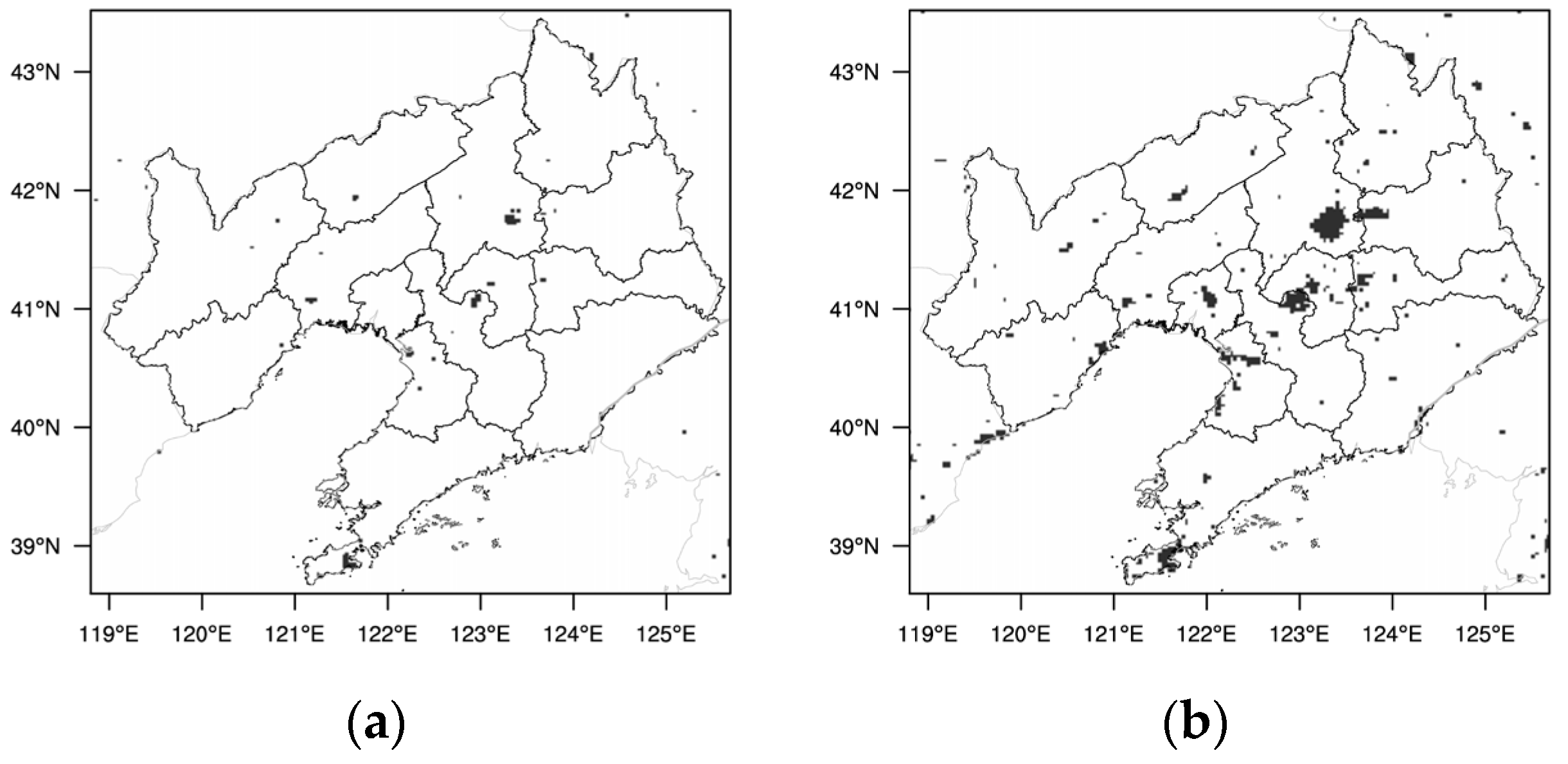
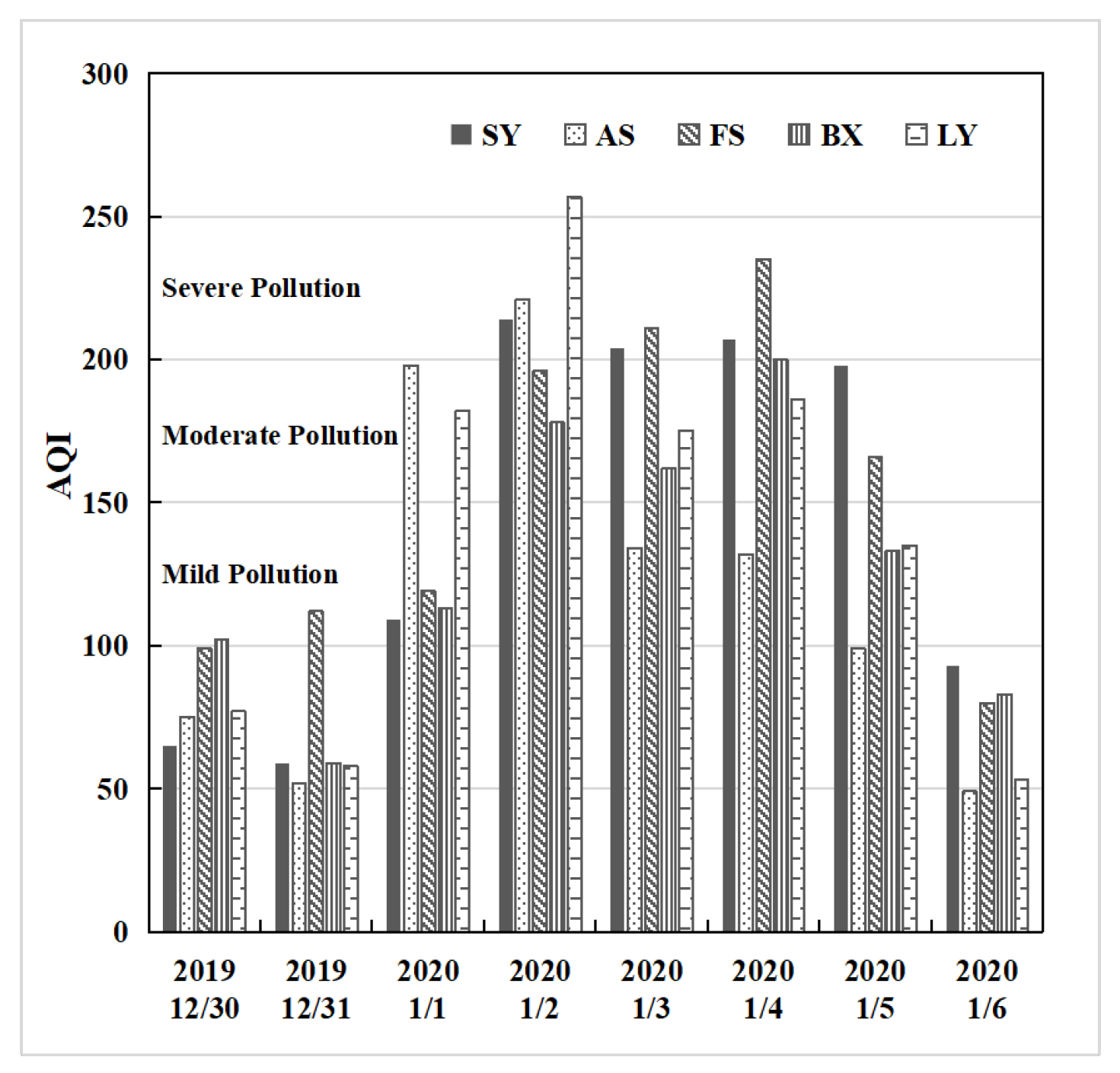

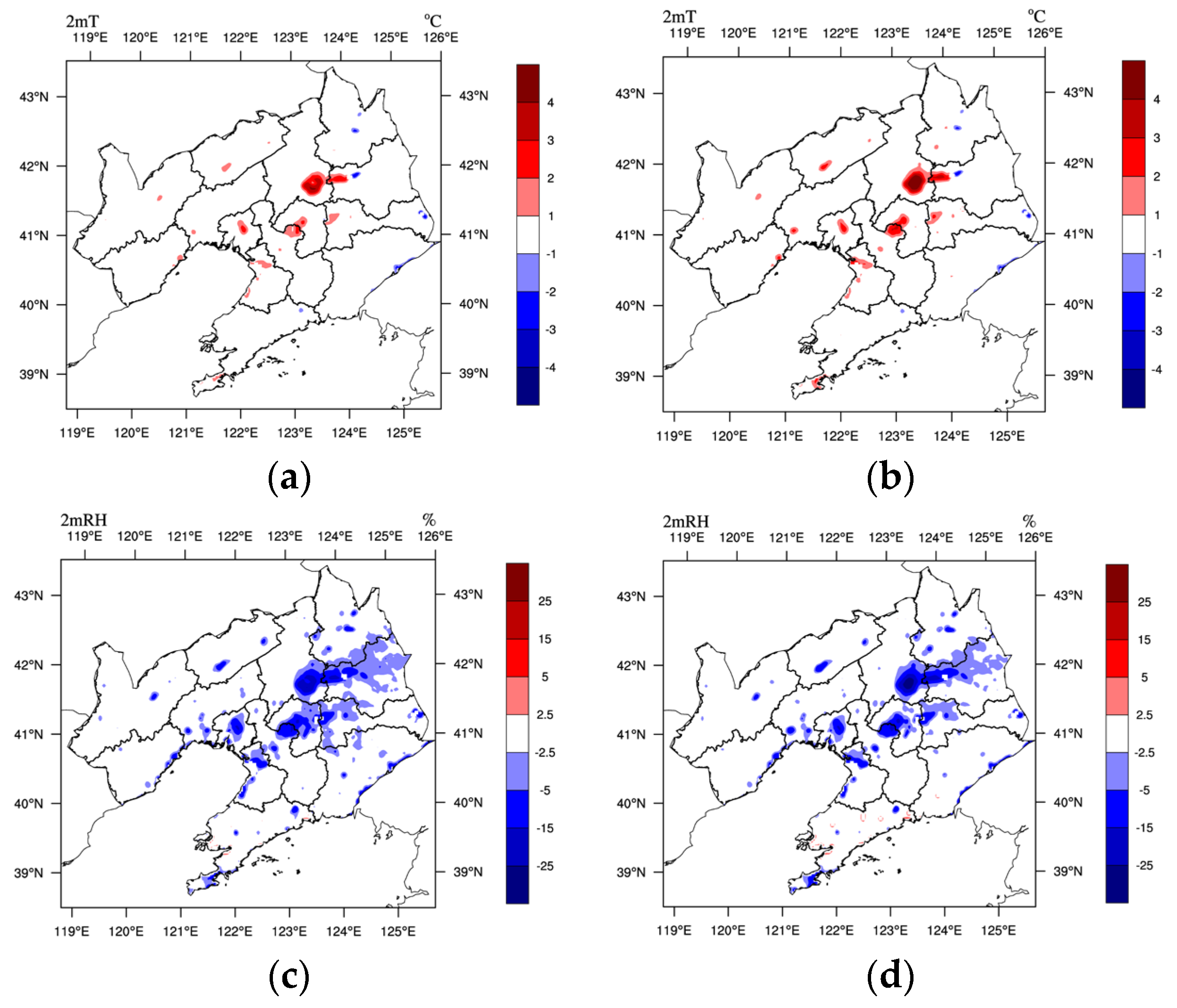
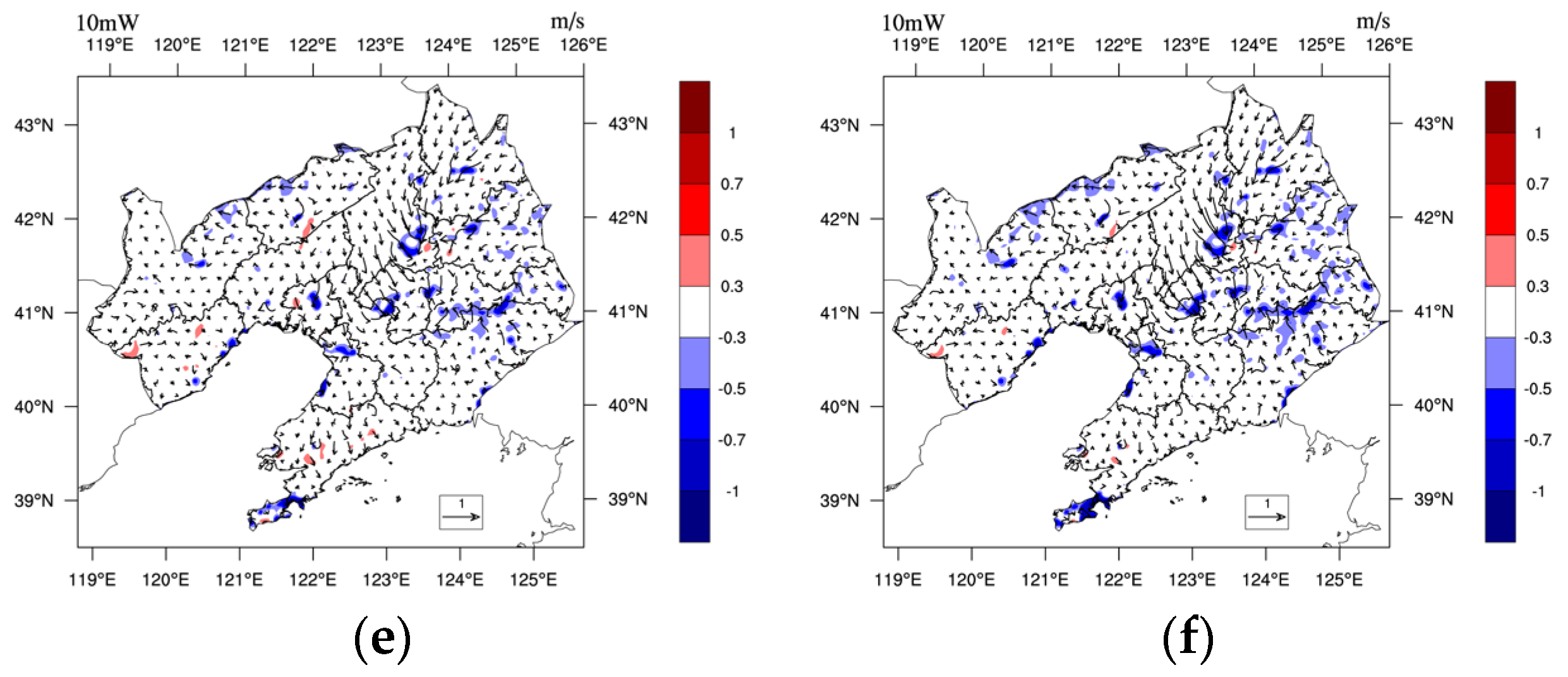

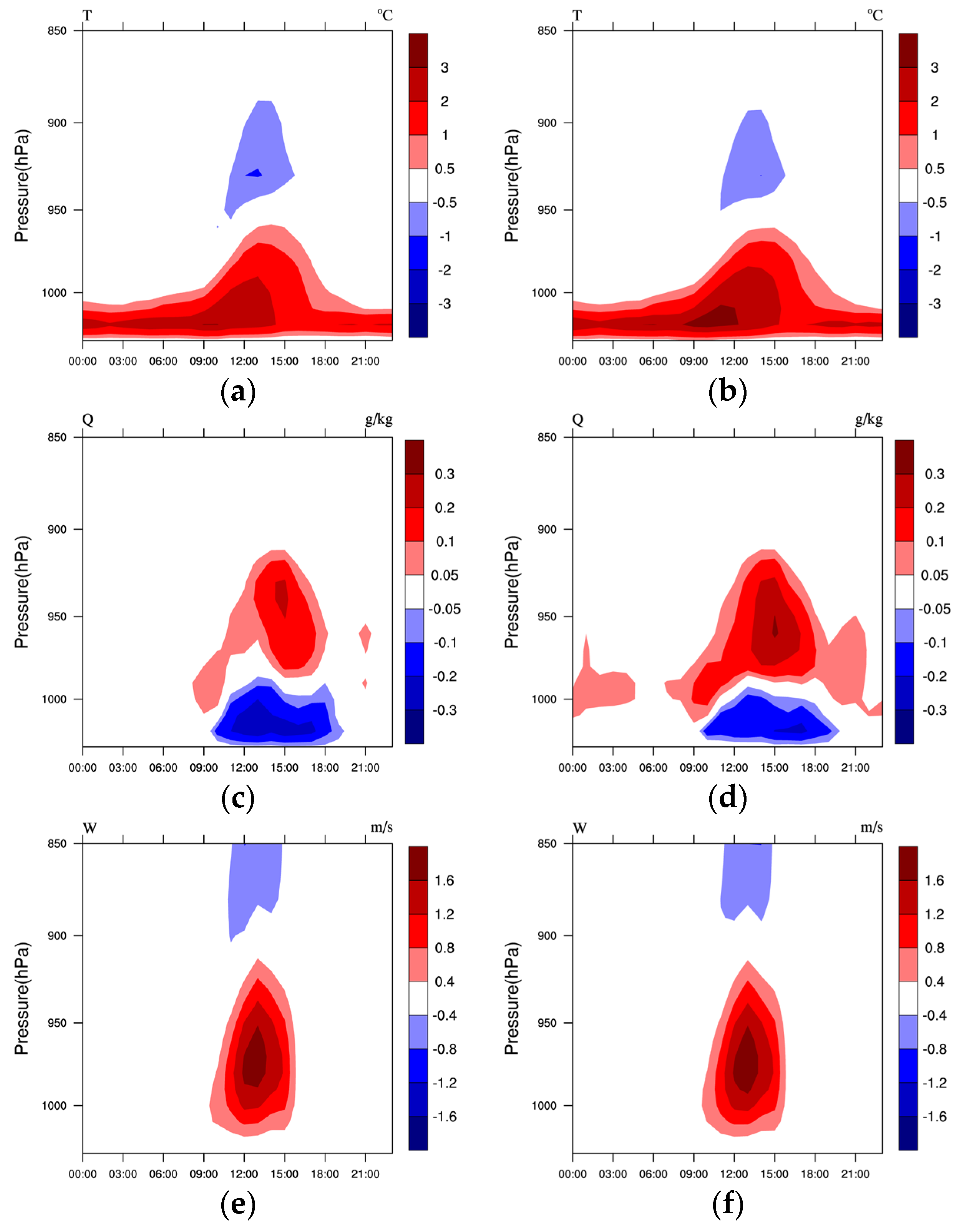
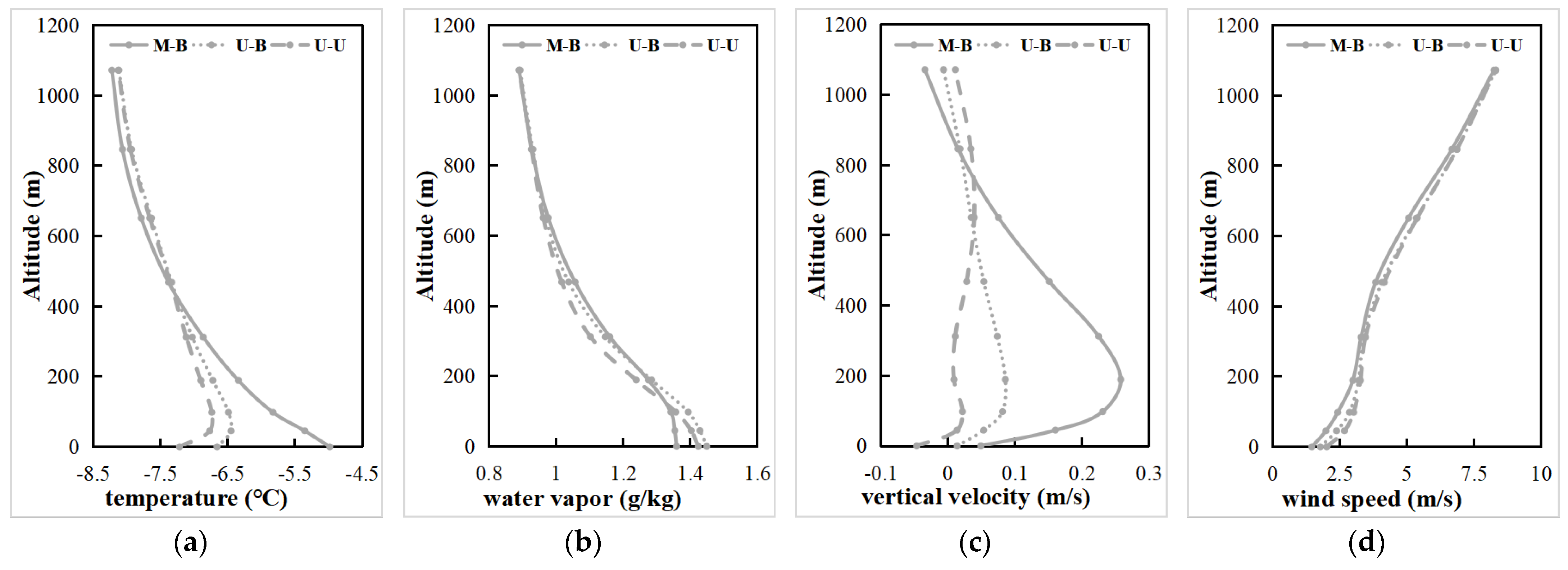


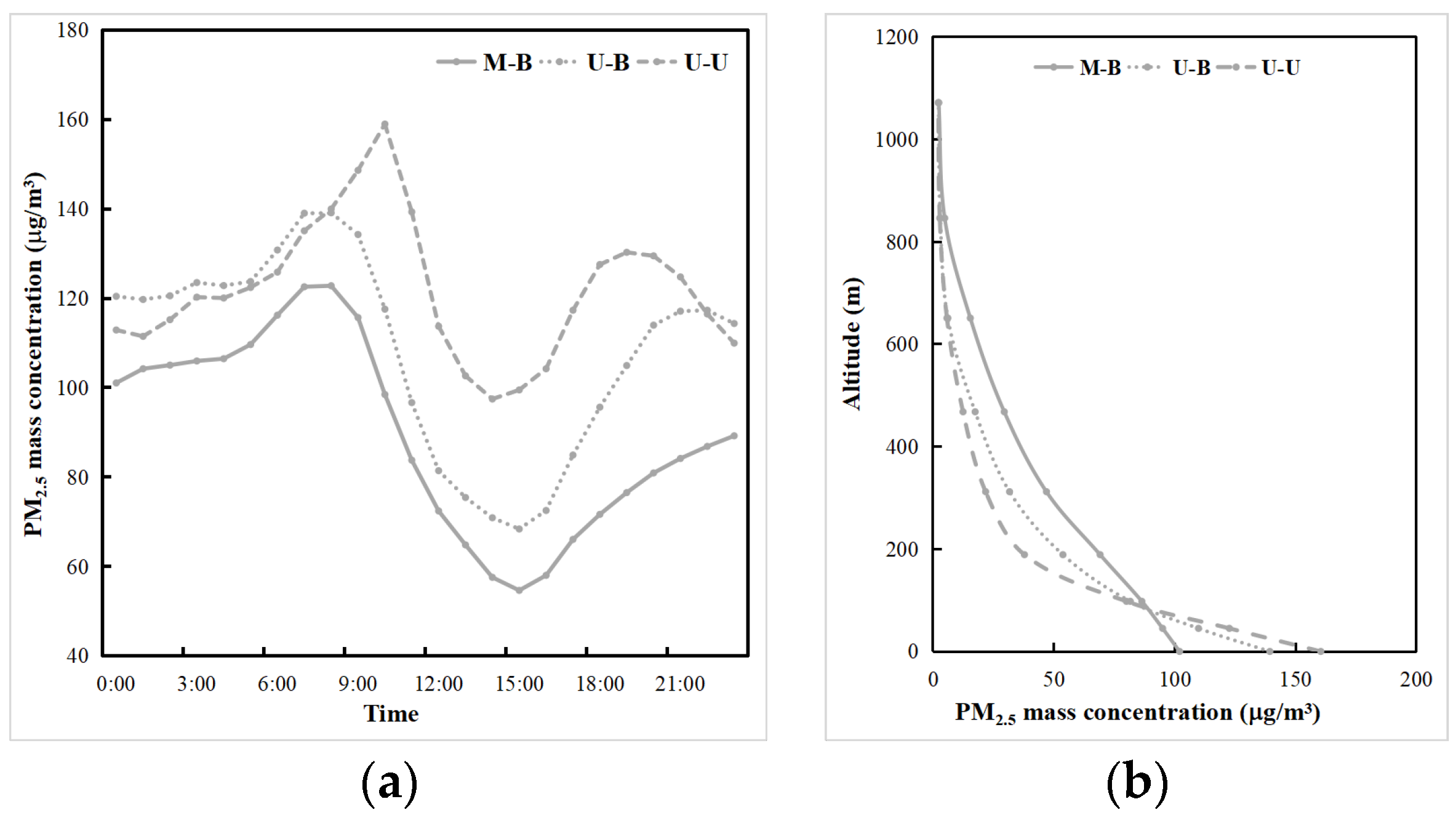
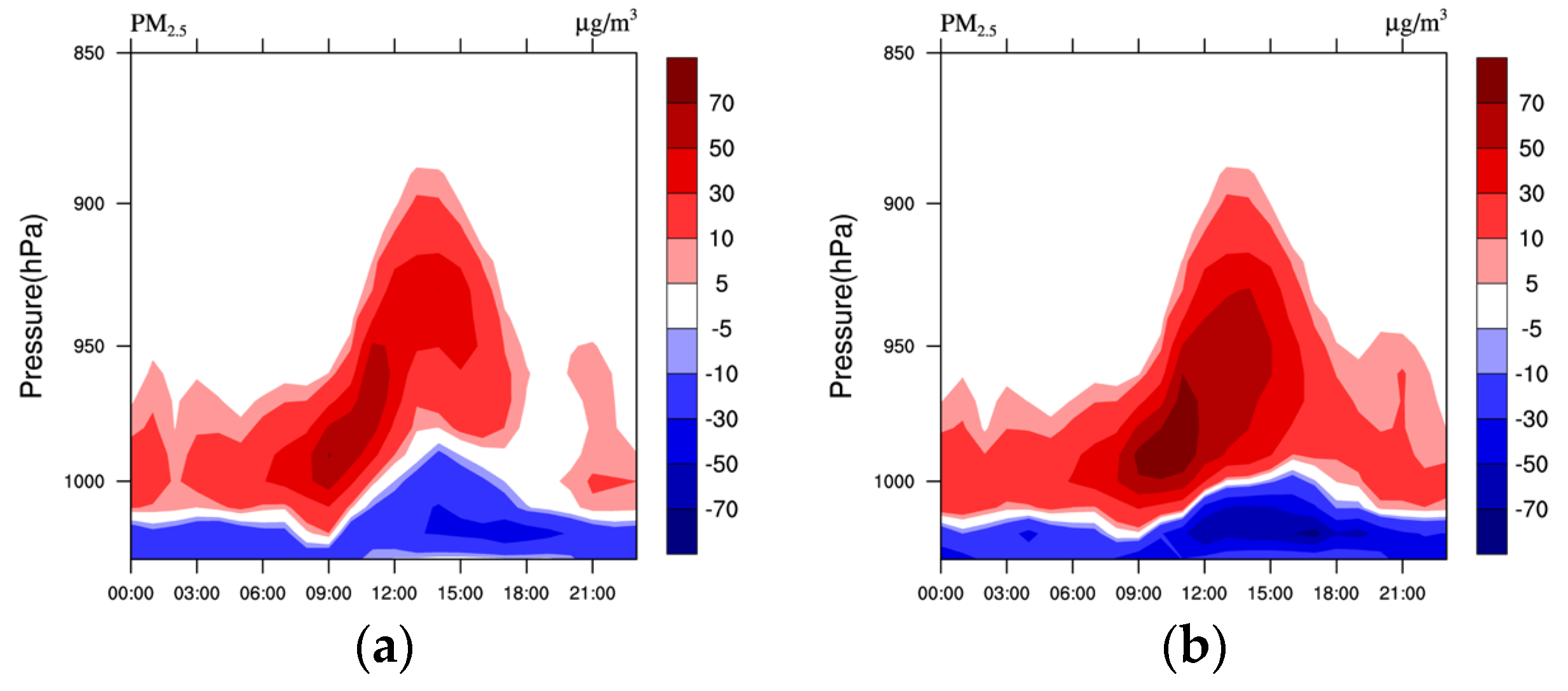
| Experiment | Land-Use Data Set | Urban Canopy Scheme |
|---|---|---|
| U-U | USGS | UCM |
| M-B | MODIS 2018 | BEP |
| U-B | USGS | BEP |
| Region | Variables | MB | GE | RMSE | R | IOA |
|---|---|---|---|---|---|---|
| SY | 2 m temperature (°C) | 1.85 | 2.54 | 3.09 | 0.93 ** | 0.91 |
| 2 m relative humidity (%) | 1.95 | 8.09 | 10.27 | 0.71 ** | 0.81 | |
| 10 m wind speed (m/s) | 1.44 | 1.53 | 1.94 | 0.40 ** | 0.19 | |
| Near-surface PM2.5 (µg/m3) | 27.52 | 55.65 | 65.97 | 0.48 ** | 0.63 | |
| CLCC | 2 m temperature (°C) | 1.24 | 2.10 | 2.42 | 0.95 ** | 0.94 |
| 2 m relative humidity (%) | −0.99 | 8.62 | 10.73 | 0.57 ** | 0.74 | |
| 10 m wind speed (m/s) | 0.90 | 0.99 | 1.28 | 0.50 ** | 0.27 | |
| Near-surface PM2.5 (µg/m3) | −1.62 | 31.20 | 41.81 | 0.58 ** | 0.76 |
| Effect | SW | LW | Rn | ||||||
|---|---|---|---|---|---|---|---|---|---|
| Mean | Daytime | Nighttime | Mean | Daytime | Nighttime | Mean | Daytime | Nighttime | |
| LU | 9.36 | 24.96 | 0.00 | −10.93 | −13.36 | −9.47 | −1.57 | 11.60 | −9.47 |
| LUUC | 9.77 | 26.07 | 0.00 | −13.33 | −17.26 | −10.97 | −3.56 | 8.81 | −10.97 |
| Effect | SH | G0 | LH | ||||||
| Mean | Daytime | Nighttime | Mean | Daytime | Nighttime | Mean | Daytime | Nighttime | |
| LU | 40.49 | 75.39 | 19.55 | −37.02 | −49.43 | −29.57 | −4.89 | −13.00 | −0.02 |
| LUUC | 57.73 | 101.40 | 31.53 | −57.30 | −75.88 | −46.15 | −4.87 | −12.88 | −0.06 |
Disclaimer/Publisher’s Note: The statements, opinions and data contained in all publications are solely those of the individual author(s) and contributor(s) and not of MDPI and/or the editor(s). MDPI and/or the editor(s) disclaim responsibility for any injury to people or property resulting from any ideas, methods, instructions or products referred to in the content. |
© 2023 by the authors. Licensee MDPI, Basel, Switzerland. This article is an open access article distributed under the terms and conditions of the Creative Commons Attribution (CC BY) license (https://creativecommons.org/licenses/by/4.0/).
Share and Cite
Wang, D.; Wang, Y.; Li, X.; Shen, L.; Zhang, C.; Ma, Y.; Zhao, Z. Modeling Impacts of Urbanization on Winter Boundary Layer Meteorology and Aerosol Pollution in the Central Liaoning City Cluster, China. Toxics 2023, 11, 683. https://doi.org/10.3390/toxics11080683
Wang D, Wang Y, Li X, Shen L, Zhang C, Ma Y, Zhao Z. Modeling Impacts of Urbanization on Winter Boundary Layer Meteorology and Aerosol Pollution in the Central Liaoning City Cluster, China. Toxics. 2023; 11(8):683. https://doi.org/10.3390/toxics11080683
Chicago/Turabian StyleWang, Dongdong, Yangfeng Wang, Xiaolan Li, Lidu Shen, Chenhe Zhang, Yanjun Ma, and Ziqi Zhao. 2023. "Modeling Impacts of Urbanization on Winter Boundary Layer Meteorology and Aerosol Pollution in the Central Liaoning City Cluster, China" Toxics 11, no. 8: 683. https://doi.org/10.3390/toxics11080683
APA StyleWang, D., Wang, Y., Li, X., Shen, L., Zhang, C., Ma, Y., & Zhao, Z. (2023). Modeling Impacts of Urbanization on Winter Boundary Layer Meteorology and Aerosol Pollution in the Central Liaoning City Cluster, China. Toxics, 11(8), 683. https://doi.org/10.3390/toxics11080683







